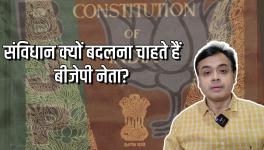LIC’s IPO: A Scam of Gigantic Proportions
The old and cliched adage, ‘act in haste, repent at leisure’, perhaps best sums up the Narendra Modi government’s headlong rush to sell a portion of its stake in India’s premier life insurance company, the Life Insurance Corporation of India (LIC).
The Modi government’s handling of India’s biggest-ever IPO shows an extraordinary disregard of public interest, while pandering to the whims and fancies of global speculators who have bargained hard to get the shares at a heavily discounted price. The government’s egregious disregard for the interests of millions of policy holders, who have been instrumental in developing and nurturing not just LIC but the culture of life insurance in India, while favouring a handful of international speculative interests, has only confirmed the suspicion that the LIC float has all the hallmarks of a gigantic scam — perhaps, the biggest in the annals of privatisation in India.
On Saturday, April 23, the LIC Board, clearly under pressure from the Union Finance Ministry, decided to lower the extent of the planned disinvestment, from 5% to 3.55%. On April 26, the LIC Board met to formally decide on the launch dates of the float as well as the extent of discounts on the issue price that are to be offered to policyholders and employees, as well as other details. The LIC is expected to file its formal Red Herring Prospectus with the market regulator, the Securities and Exchange Board of India (SEBI), on April 27. The details are likely to revealed formally at a media conference later in the day..
Overtaken by exceptional circumstances, most notably the war in Ukraine and the turmoil it has set off in the global markets, the government was running against a tight deadline that lapses by May 12. The government, which had initiated the first formal step toward shedding a part of its stake in LIC in February by filing its Draft Red Herring Prospectus (DRHP) with SEBI, had time till then to proceed with the controversial IPO. Missing that deadline would have required it to file fresh and updated data on its performance, which would have delayed the IPO. Whether this compulsion can in any way justify the reckless rush to disinvest is the crucial question hanging in the air.
Pricing LIC Share at Deep Discount
The planted media reports in the past few days, sourcing comments by unnamed officials in the Finance Ministry, indicate that the government plans to reduce the IPO’s size — from about Rs. 70-75,000 crore to about Rs. 21,000 crore. There are two ways in which the issue size can be reduced: either a smaller number of shares are offloaded, or, by reducing the price of each share that is to be offered to prospective shareholders. The “quantity” effect arises from a 30% reduction in the number of shares to be offloaded by the government.
Read More: The LIC IPO: Undervaluing India’s Crown Jewel -- I
According to the DRHP, the government had planned offload 31.625 crore shares, representing 5% of LIC’s equity base of 632.50 crore shares. The number of shares to be offered is now to be pared down to 22.1375 crore shares, representing 3.5% of LIC’s equity base. There is nothing that appears irregular in this so far, unless, of course, one argues, as this author does, against the very logic of privatisation of India’s most successful insurance company.
It turns out that the “price effect” is where the Finance Minister’s sinister design is revealed in all its malevolent glory. Let me explain how. The latest estimate of Embedded Value (EV) of LIC, estimated by Milliman Advisers and revealed in the DHRP, was estimated at Rs. 5.40 lakh crore. This implies that the base value of each share — never mind for now the inadequacies of the concept of EV itself — is worth Rs. 853.
Investors Gain, Policyholders Lose
Initially, just about two months ago, it was expected that the real worth of each LIC share would be arrived at by applying a multiplication factor of between 2.5 and 3. This would imply a per share valuation ranging between Rs. 2,133 and Rs. 2,559. A 5% stake sale, amounting to the sale of 31.625 crore shares, would have fetched the government somewhere between Rs. 67,456 crore and Rs. 80,928 crore.
Reports in the media indicate that the government, under relentless haranguing by international investors who have cited “adverse market conditions”, is now preparing to scale down the valuation dramatically by using a multiplication of just 1.1 times LIC’s estimated EV, which is itself a grossly inadequate measure of the true worth of India’s biggest life insurer (and one of the biggest in the world). There is no justification for applying a much lower multiplication factor, especially because much smaller private life insurers have applied a factor of between 2.5 and 3 times their EVs. Surely, the LIC, with a much longer track record and bigger market share, deserves a much higher multiplication factor.
Applying the much lower multiplication factor of 1.1 means that each share to be offloaded would be worth about Rs. 938. At the lower bound of the earlier valuation, this is about 44% cheaper; at the higher bound of the earlier valuation, the discount being offered is 63%. To make an even better comparison, let us estimate how much the government would have raked in through a 3.5% stake sale, amounting to the offer of 22.1375 crore shares.
Applying the multiplication factor that was justified in February — between 2.5 and 3 — this would have fetched the government between Rs. 47,219 crore and Rs. 56,650 crore. The reports circulating in the media indicate that with a discounted multiplier of 1.1, the 3.5% share sale, with a per share price tag of Rs. 938, would result in the government receiving Rs. 20,765 crore. The implicit loss to the exchequer, even if one forgets for the moment the utter idiocy of the privatisation exercise, would range between Rs. 26,443 crore and Rs. 35,885 crore.
What is this if not a scam?
There is no way a company that has pioneered life insurance in India, which commands a market share of almost two-thirds, whose investments exceed that of the entire mutual fund industry, and whose track record is without a blemish over six decades, can be allowed to be “valued” by capricious investors out to make a fast buck at the cost of millions of policyholders. This is the reason why the LIC IPO, properly speaking, can only be construed as a gigantic scam.
The Valuation Game
Even the base value provided by the EV is a gross underestimation of LIC’s true worth . It is important to reiterate that the valuation exercise, based on the notion of the EV, which has been adopted and sanctified by the insurance regulator, the Insurance Regulatory Development Authority of India, is responsible for the gross undervaluation of LIC. That is, the EV itself, supposedly the estimate of the base value of a life insurance company’s worth, is grossly inadequate to provide a true measure of the worth of a unique finance institution like LIC.
It is important to emphasise that the evolution of the EV as a conceptual measure of a life insurance company’s worth is of recent vintage, particularly after the global financial crisis, which resulted in a wave of mergers and acquisitions in the global life insurance business after the collapse of several insurance companies.
In essence, the EV tries to provide a summarised answer to the question: how much is a life insurer’s potential return worth to an acquirer of the business? This is the narrow basis on which the notion of the EV is constructed. In fact, a paper by a Canadian actuary (2006), Frédéric Tremblay, observed that the notion of EV “must be used carefully” because these depend critically on the underlying assumptions that are made for the valuation.
In fact, speaking about valuation in another context, Aswath Damodaran, Professor of Finance at Stern School of Business, New York, widely regarded as a “valuation guru”, has repeatedly stressed that any valuation depends critically on the underlying assumptions that are made, often reflecting the biases of the valuer. Further, a more recent paper by two Czech scholars concludes that excessive reliance on EV to determine valuations is risky. Instead, they suggest that, one, other method be used in addition to EV in order to arrive at a better approximation of the value of an insurance business.
One of the most striking elements missing from the EV computation in the case of LIC is that Milliman has totally eliminated the value of assets in its possession. This is a striking omission given the fact that LIC is perhaps India’s biggest realtor with prime properties in not just all Indian metros and large cities but across the length and breadth of the country. There are no reliable estimates of what the worth is of its real estate assets are, but some put the value at several lakh crore rupees, far in excess of the EV estimated by Milliman.
The LIC has itself never made an estimate of the value of these assets because it never had the need to. But the fact that dilution of government stake in favour of private entities implies that they would now have a claim on the assets in LIC’s possession by virtue of being its new owners indicates that the lower valuation directly benefits the new owners who have played no role in the acquisition of these assets.
Under-Valuation and Expropriation of Policyholders
The most obvious fact that stares out of the DRHP is the manner in which millions of existing policyholders have been expropriated. In fact, the spectacular increase in the LIC’s EV — from Rs. 0.96 lakh crore in March 2021 to Rs. 5.40 lakh crore in September 2021 (within six months) — is directly attributable to the changes made to the LIC Act.
The changes, in one fell swoop, deprive holders of participatory policies, who were earlier entitled to 95% of the surplus that accrue from non-participatory polices because they participate in the risk associated with such policies.
The spectacular increase in EV has been made solely possible by snatching away the rights of policyholders and transferring them to “shareholders”. Perversely, the increase in EV, a measure of what shareholders command, is explicitly based on the expropriation of the rights of millions of policyholders who have deployed their savings.
Seen from this perspective, the low valuation is a scam on two counts: one, it deprives the government of “revenues” that it would have earned from the IPO. But, even more importantly, it snatches away the rights of policyholders and transfers the gains to private entities that have played no role whatsoever in building and nurturing LIC over the decades.
Media gossip in the past few days speaks of how international “investors” are behind the aggressive discounts that are being considered by the Modi Government. Isn’t it preposterous and shocking that these potential “purchasers” of the LIC stock in the IPO, particularly the so-called “anchor investors”, should be telling the government what the price ought to be? Wouldn’t it be ridiculous to term such a sale as happening in a “market” where prices are supposedly determined by the “free” will of the participating agents?
Who are LIC’s True Owners?
Pundits in the media, by the way, have scrupulously avoided the biggest question in the LIC story: who really owns LIC? They have been so sympathetic to the government so as to argue that lower valuation is the result of factors completely outside the government’s control. This is not even clever. For one, even if one agrees with the idea of the LIC IPO (which in itself is preposterous), why would you agree with a valuation that is so deeply discounted within a matter of less than three months?
Since we are talking about a pioneering insurance company that was uniquely structured, unlike any other in the world, would propriety not have required the government to approach the market at a later time? It is almost as if the Modi government willed itself to be painted into a corner by a bunch of buccaneering investors.
The argument that policyholders are eligible for shares in the IPO is not even clever, it is positively perverse. First, there is little doubt that policyholders as a class, not individual policyholders, are being shortchanged en masse. Second, millions of policyholders, especially those holding policies with small-ticket size policies, may not be in a position to enter the stock market, or may not even have the desire to do so. The fact that they will be deprived as a class cannot be rectified merely by formally “allowing” them to participate in the lottery called the IPO.
Third, is it not striking that not a single voice in the media has raised a murmur about the very idea of reserving a portion of the IPO for policyholders, whom the government now regards as the LIC’s “customers” with no ownership rights, which is what the LIC’s legacy affirms?
Is there a single other public issue in the history of the Indian capital markets where a company has given shares to its “customers”? It would have been preposterous for PayTM to have sold shares at discounted prices to its customers; much the same applies to LIC.
The only conceivable reason why this is happening is that it is a tactical move to blunt the opposition by millions of policyholders who are at risk of losing their status as “owners” of LIC, which was structured as a giant cooperative enterprise in which the government acted as a trustee, not an outright owner. That the trustee has turned rogue is confirmed by the IPO.
The IPO is the First Step in LIC’s Demolition
The IPO threatens to have long-term consequences for LIC. The market regulator’s stipulations imply that it would have to approach the market again within two years in order to have a public holding of at least 10% and 25% within five years. The deep discount offered in this IPO will likely subdue the price at which further dilution of government stake happens.
It appears that the government is banking on extracting a “feel good” effect from a “pop” in the share price that happens soon after listing. Remember what happened with the IRCTC IPO in 2019? The share’s issue price was set at Rs. 315-320 per share, but on the day of listing it opened at Rs. 644. Neither the government nor millions of LIC policyholders would gain a paisa from the “pop” that would arise when the share is listed; instead, it is only sharp investors who will be laughing their way to the bank.
Perhaps, the Modi government is banking on sharp gains for speculative sharks who would exit after extracting a premium that directly arises from losses to the government and millions of policyholders. For a government that has been forever in feel-good mode, this is perfectly understandable. But, for millions of Indians, the IPO planned for May 4 would mark the beginning of the demolition of one of India’s most popular institutions.
The writer is former associate editor, ‘Frontline’, and has worked for The Hindu Group for over three decades. He is a member of the People’s Commission on Public Sector and Public Services. The views are personal.
Get the latest reports & analysis with people's perspective on Protests, movements & deep analytical videos, discussions of the current affairs in your Telegram app. Subscribe to NewsClick's Telegram channel & get Real-Time updates on stories, as they get published on our website.
























